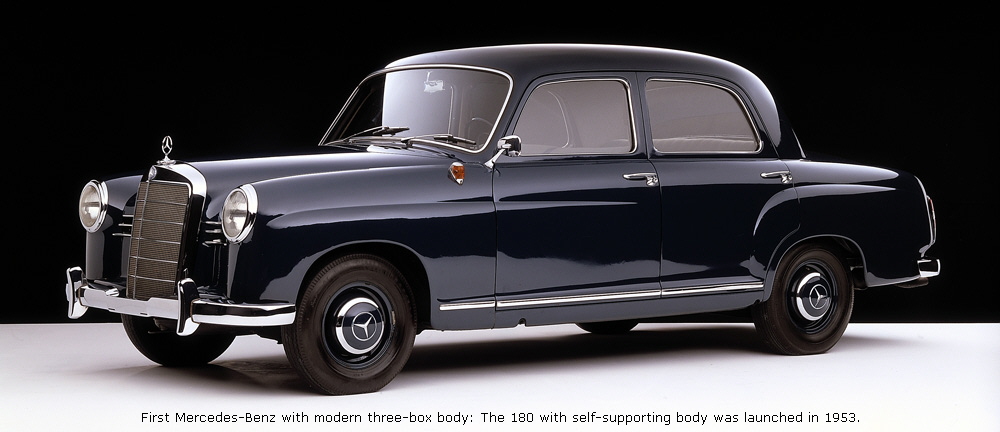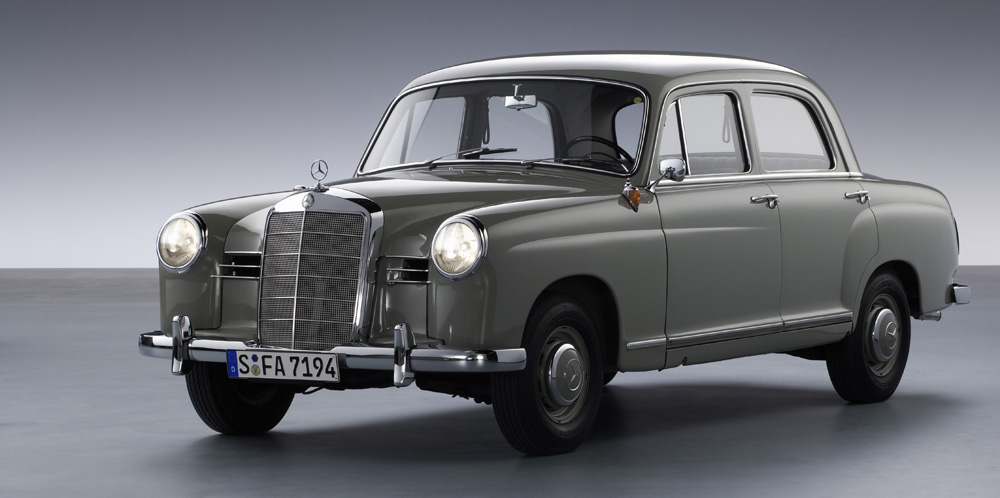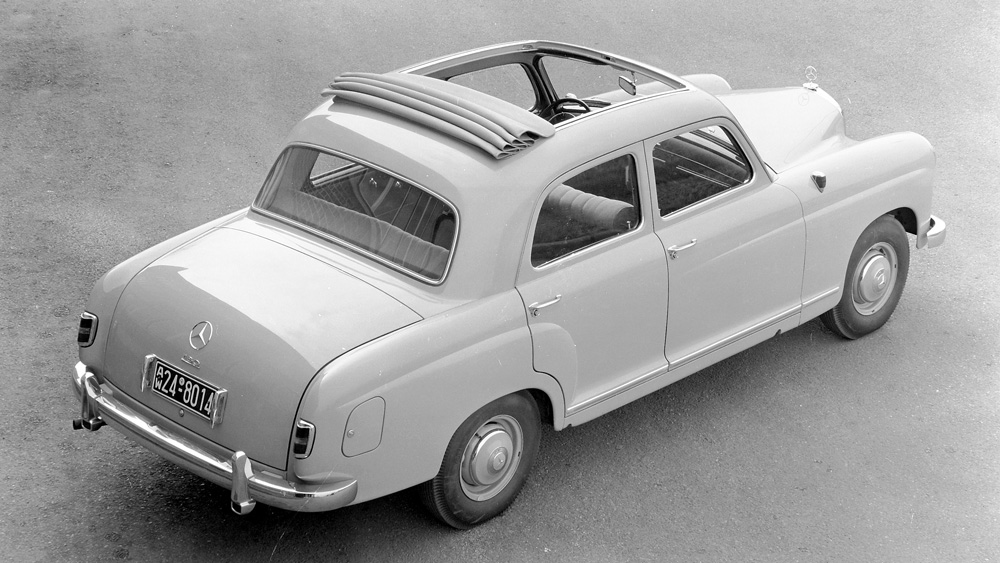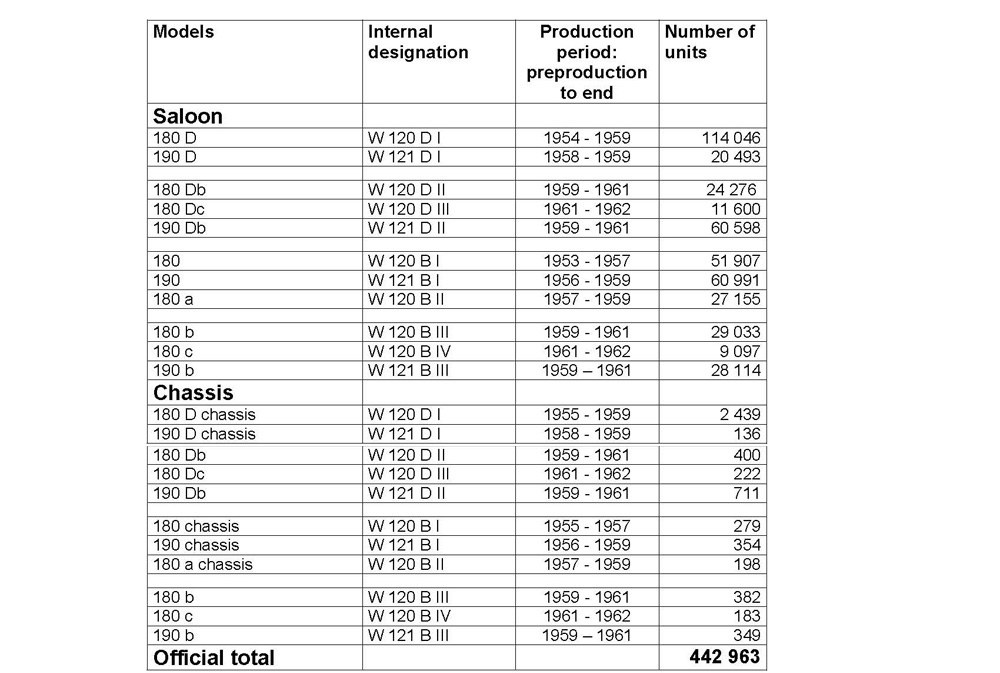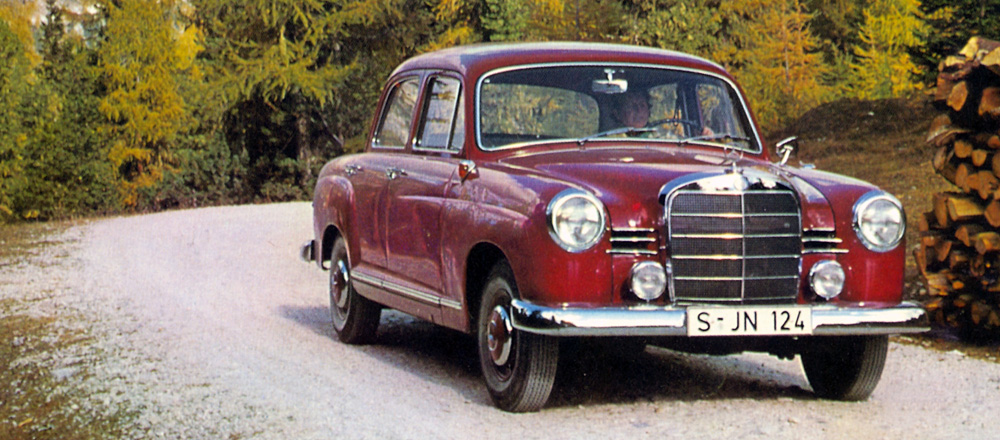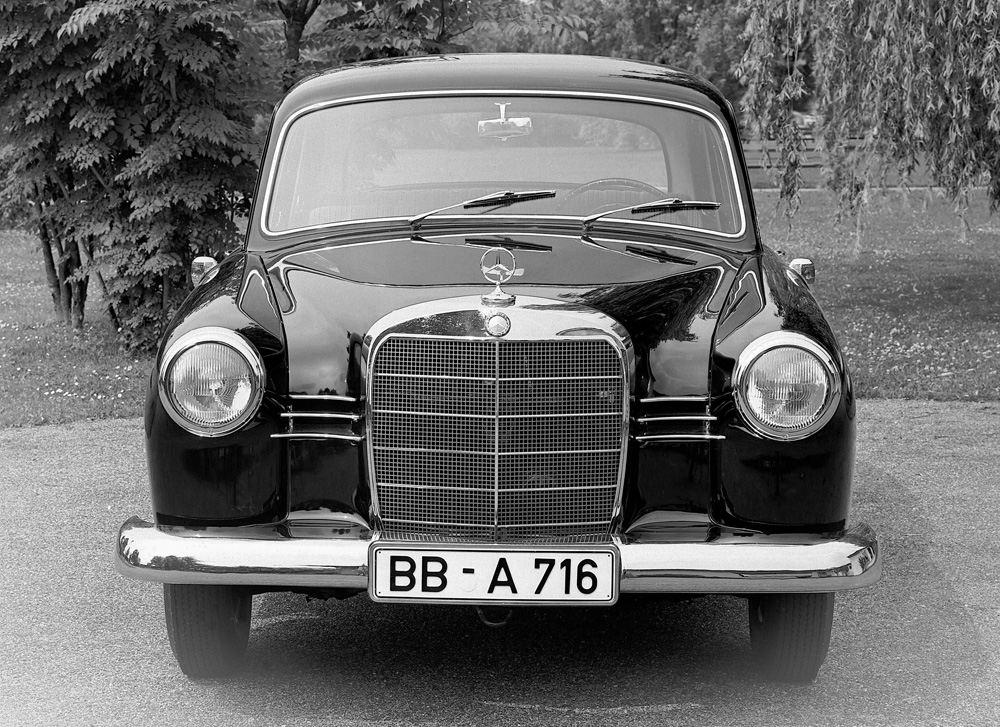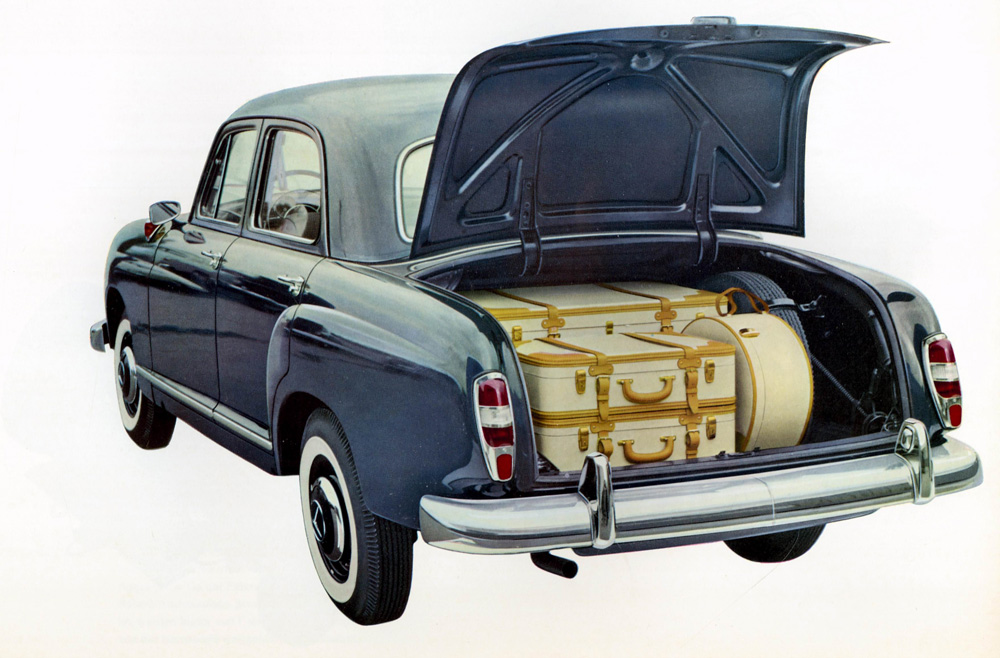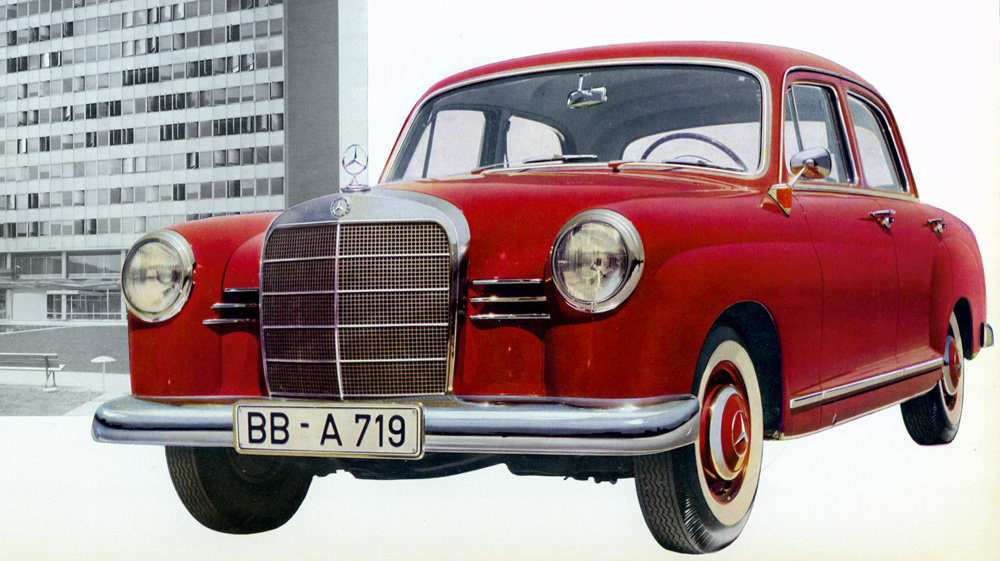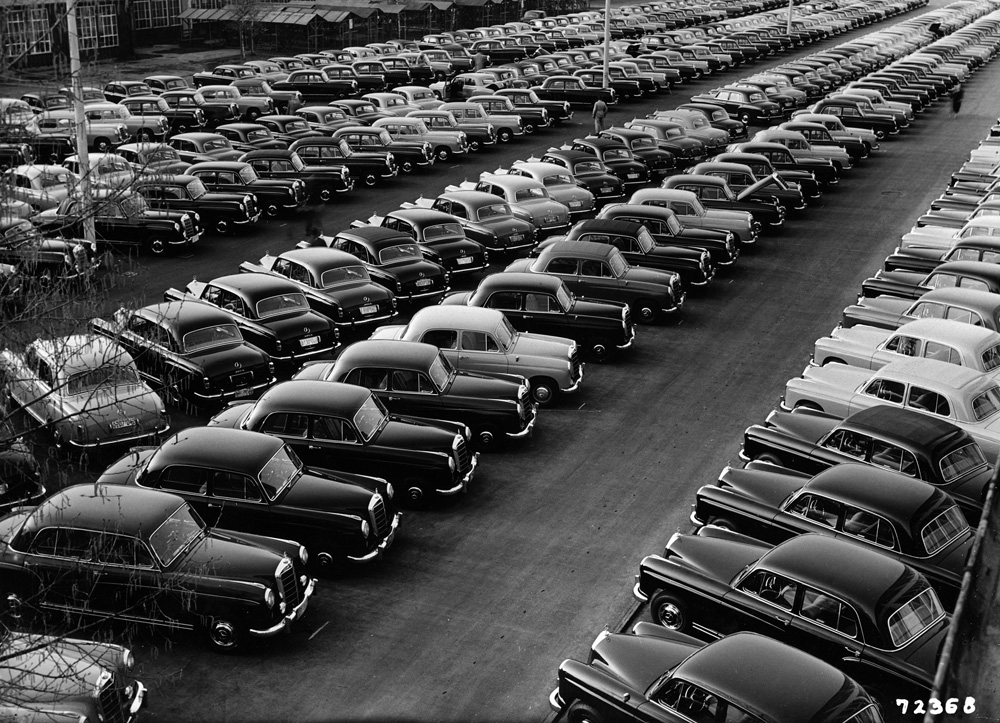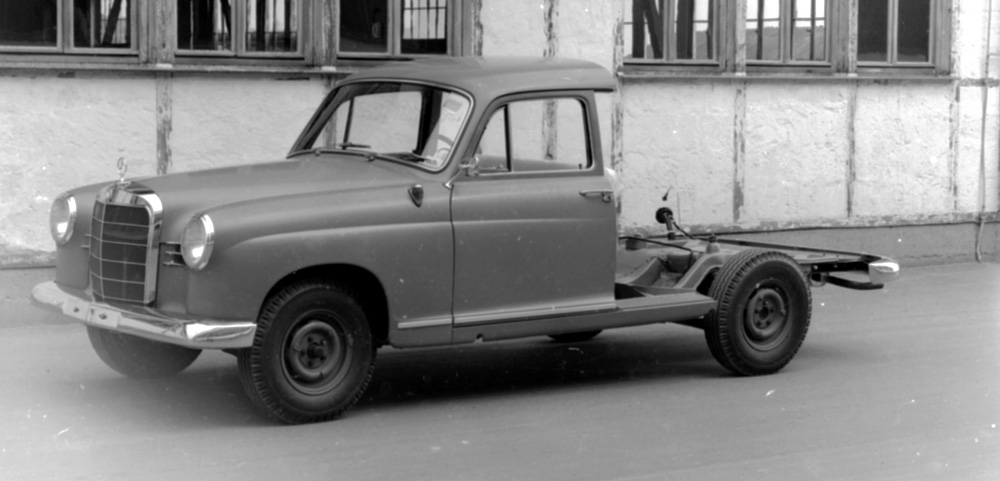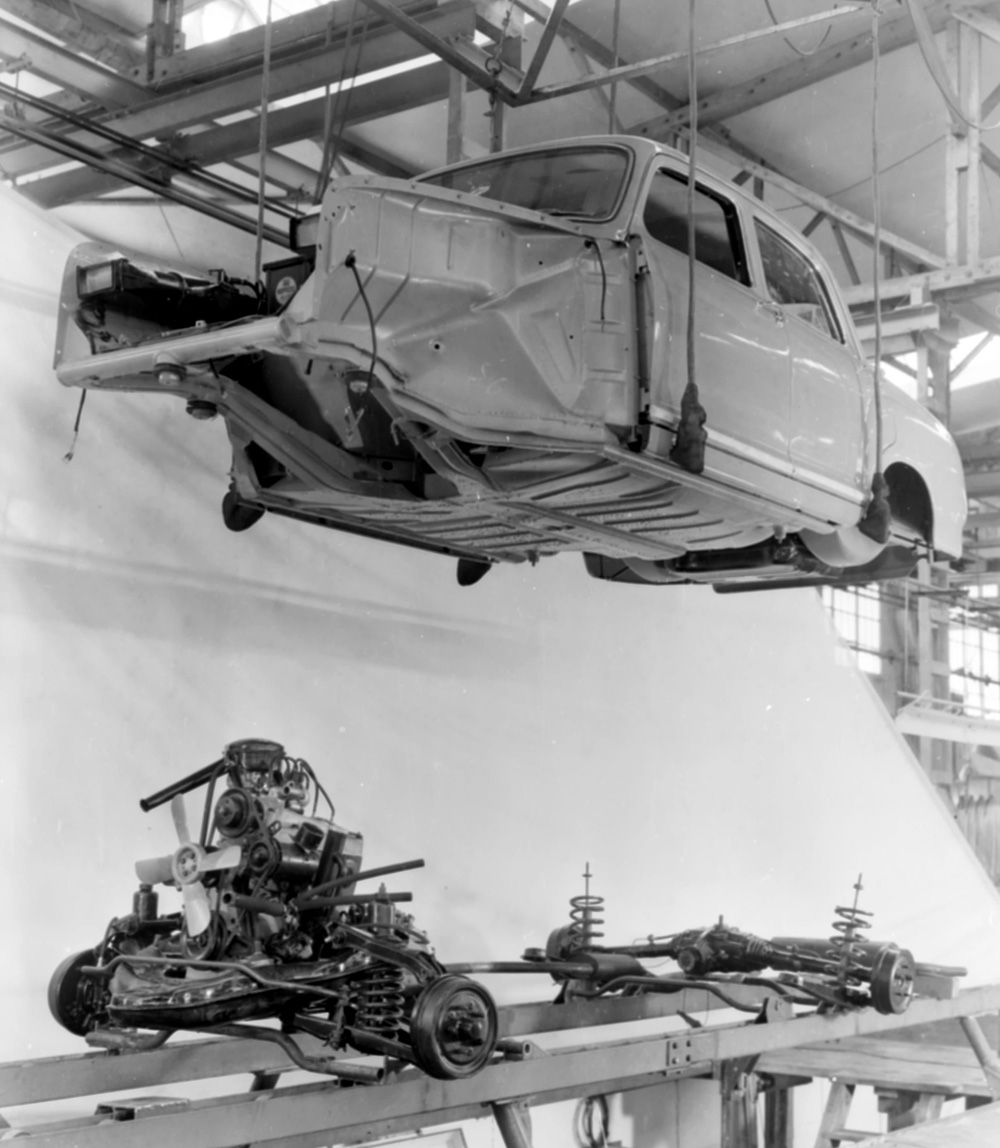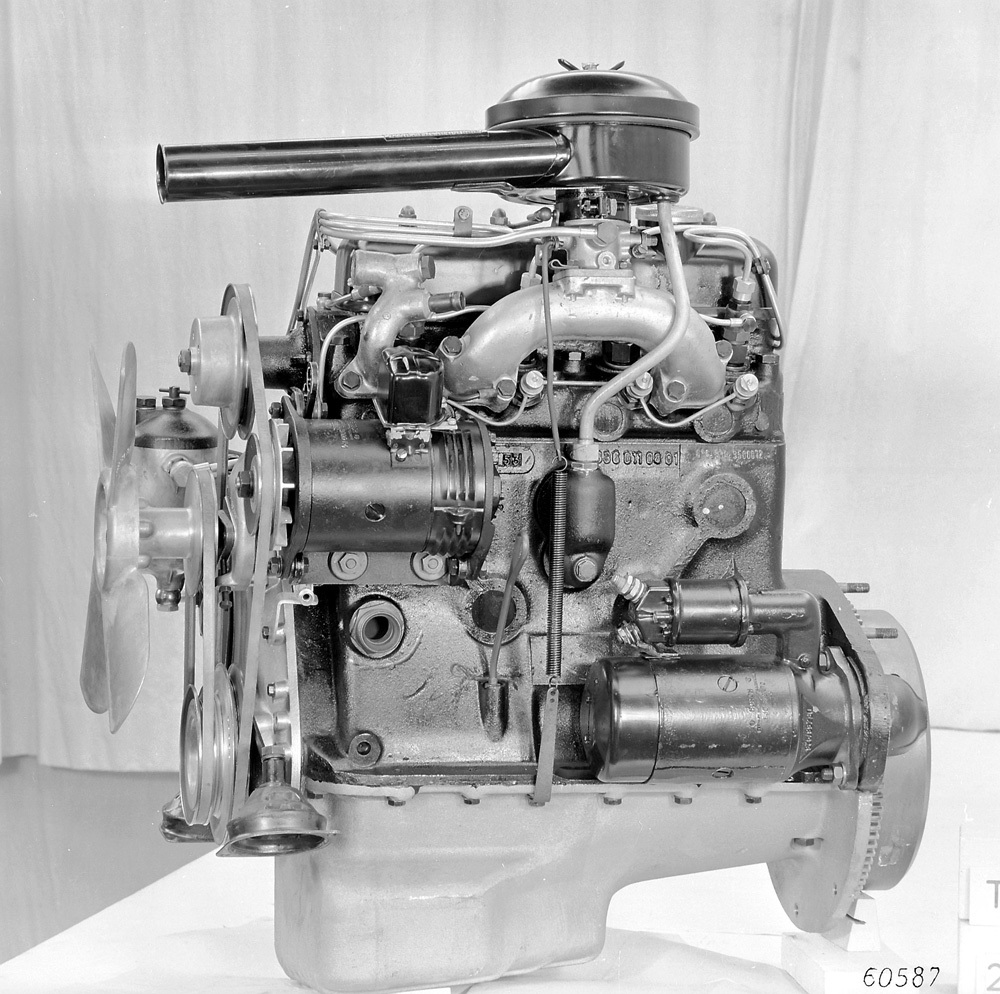|
|
|
Mercedes-Benz 120 and 121 series (1953 to 1962) At its launch in August 1953, the new Mercedes-Benz represented a formal and technical break with pre-war traditions. These were the traditions that had moulded the W 136 and W 191 series, along with the 300 and 220 models. The W 120 was now the first Mercedes-Benz car to feature a three-box design with self-supporting chassis/body structure, known in Germany as the "Ponton". Characteristic of the three-box principle, first realised in a body in the USA in 1946, are fully integrated wings, a rectangular body outline, and the almost square-hewn shape of the front end, the passenger compartment, and the rear end. At the same time, the concept allowed for reduced wind resistance (resulting in less wind noise and improved fuel consumption), as well as an appreciably more spacious interior. The 180 model became a basis from which Mercedes-Benz derived further vehicles in the upper mid-size category with petrol and diesel engines, and starting in 1954 also the luxury saloon of the 220 family (series 180 and 128 with six-cylinder engines) and the 219 model (W 105) in 1956. The 190 SL sports car presented in 1955 was also a variant of the three-box Mercedes-Benz 190 saloon (W 121), which was developed by Mercedes-Benz at the suggestion of US importer Maxi Hoffmann. Whereas the 190 SL model had an independent body, design of the luxury cars closely followed that of the 180. The 220 a model and its successors differed basically from the upper mid-range model only by a longer wheelbase (2.82 metres instead of 2.65) – and consequently more spacious interior – a longer front end, and six-cylinder power plants instead of the four-cylinders of the 180 and 190 models. The 219 model (W 105), delivered from 1956 onwards, had the smaller body of the four-cylinder models; it was the first six-cylinder vehicle in the E-Class. Self-supporting body For the first time in the history of Mercedes-Benz passenger cars, the 180 model had a body designed as a self-supporting unit. The metal panels of the body were solidly welded to the frame-floor system with which it formed a single structural unit. Compared to the conventional design, which consisted of a body mounted on a frame, this design increased torsional stiffness at the same time as reducing weight. The 180's design characteristics made it an ultramodern automobile of its day. The new saloon received an enthusiastic verdict from the experts. The chassis was also improved on certain points. Compared with the 170 Sb model, the front wheels, located by double wishbones, were now no longer attached directly to the frame, but to a so-called subframe. This was a U-shaped axle carrier, welded together from two pressed metal parts, and to which not only the front suspension, but also the engine, transmission and steering were attached. The subframe was mounted to the front section of the frame by means of three noise-reducing silent blocks. The rear suspension made use of the tried and tested swing axle, but now additionally had the two wheels located by radius rods set far apart. 1954: Diesel drive in the "Ponton" In January 1954, the 180 D model was added to the 120 series. This subsequently turned out to be the most successful of the four-cylinder "Ponton" models, with almost 150,000 units being built in total. The model was especially popular among taxi drivers. Apart from the diesel engine adopted from the 170 DS, the 12-volt on-board electrical system and a modified rear axle ratio, the saloon with the prechamber diesel OM 636 VII (29 kW/40 hp) was identical with its petrol-driven sister model, that model being powered by the 38 kW (52 hp) M 136 VII L-head petrol engine borrowed from the 170 Sb; its basic design went back to the 170 V model. The two models of the 120 series was given a new rear axle construction in September 1955. This single-joint swing axle with low pivot point had been introduced one-and-a-half years earlier in the 220 a model. This made for improved handling characteristics owing to smaller changes in track and camber. 1956: Mercedes-Benz 190 The model 190 (W 121) with M 121 B I petrol engine added a third vehicle to the four-cylinder "Ponton" model range in March 1956. The 190 was extensively based on the proven 180 model, but had a distinctly more powerful engine, developing 55 kW (75 hp). The valve-in-head 1.9-litre power plant originally came from the 190 SL model, in which it generated 77 kW (105 hp). The saloon, however, had a derated variant with a lower compression ratio, a more docile camshaft and just a single compound carburettor. Compared with the 180 models, the rear part of the engine was mounted on two additional support points on the subframe. Mercedes-Benz adapted the brake system to the performance of the more powerful engine. The 190 had ribbed brake drums at the front and wider brake shoes. Externally, appointment details such as ventilator windows on the front doors and a chrome strip beneath the windows running all around the car distinguished the 190 model from its more ordinary brothers. Other telltale distinguishing features included a somewhat wider radiator grille with horizontal chrome ribs, mouldings on the air inlets to the left and right of the grille, as well as chromed rain runnels, larger tail lights, wheel rims with cooling slots and hub caps featuring a larger three-pointed star. 1957: Upgrade for the small "Ponton" models In line with the slogan, "even more valuable, but not more expensive", Mercedes-Benz subjected almost all passenger car models to a more or less apparent revision package in August 1957. The three four-cylinder saloons were given modified interior appointments, licence plate lamps incorporated into the rear bumper horns, and a recessed handle on the boot lid. The most important change concerned the 180 model: the revised version, internally designated the 180 a, now also had the 1.9-litre M 121 engine with overhead camshaft. This unit was based on the engine of the 190 model, derated to 48 kW (65 hp) through a lower compression ratio and use of a single unit carburettor instead of the compound carburettor. The appearance of the Mercedes-Benz 180 was also upgraded: unlike the 180 D model it was equipped with the bigger tail lights, air inlet mouldings and somewhat wider radiator grille of the 190 model, though without the 190's horizontal chrome ribs. From April 1958 onwards the 180 and 180 D models was also fitted with quarterlights on the front doors and the 190 hub caps with the bigger star. 1958: Second diesel "Ponton" car In September 1958 Mercedes-Benz added a second diesel-powered car to the passenger car line-up, the 190 D. Its 1.9-litre diesel engine, the OM 621 with 37 kW (50 hp), was developed by the engine specialists from the petrol engine of the 190 model. The appointments of the new model's body befitted the larger engine. The new diesel's enhanced output and improved smooth running compared with the 180 D model made it a sales hit right from the start. In 1959 the 180 model and the two diesel models got the turbo-cooled brake drums and wider brake shoes of the 190 model on their front wheels. Also, the outputs of the two petrol engines were increased to 50 kW (68 hp) in the 180 and 59 kW (80 hp) in the 190 by upping the compression ratio. The design changes of summer 1959, at the front and rear ends, for example, were even more noticeable. With them Mercedes-Benz freshened up the appearance of its upper mid-range series models. In the luxury class, on the other hand, the new six-cylinder models of the 111 series superseded the large "Ponton". 1959: Modernising the upper mid-range series The models with the modernised styling were now internally designated 180 b, 180 Db, 190 b and 190 Db. The designers made conspicuous changes particularly to the front and rear: the bonnet was now flatter, and the wider and lower radiator grille was a more suitable design for the new six-cylinder models. The bumpers were made a little more massive, but now made do without horns. And the taillights featured integral reflectors. The 190 b and 190 Db models differed on the outside from their 180 counterparts by having full length chrome strips running beneath the windows, as well as chromed rain runnels. Inside, too, the "Ponton" models benefited from the model refinements, in which passive safety played an important part. Like the new six-cylinder models features included a steering wheel with padded boss. In August 1961 the four-cylinder 190 c and 190 Dc tailfin models (W 110) replaced the 190 "Ponton" saloons. However, production of the 180 and 180 D models continued until 1962. For this extended production run the 180 D model was equipped with an entirely new engine. This variant of the OM 621 was developed from the engine in the 190 D model and generated 35 kW (48 hp) from a displacement of two litres. First Erlkönig also used as basis for bodies The Mercedes-Benz 180 had a lasting influence on German automotive terminology – even before it went to market. For the "Ponton" was the very first Erlkönig, a term used today to refer to the camouflaged prototypes of future automobiles. The term was coined by the motor magazine auto motor and sport. In 1952, the magazine published a first picture of the future Mercedes-Benz 180 together with a text parody of Goethe's Erlkönig (Erlking) ballad. This gave rise to an entire series of rhymed affronts against the automotive industry (the rhyme form was intended to mitigate the affront). The transliteration of unmasked test cars in verse form has long since gone out of fashion, but such vehicles are still labelled Erlkönig in Germany today, and the term has even found its way into the dictionary. The "Ponton" models of series 120 and 121, like their predecessors, were also available as chassis with partial bodies on which domestic and foreign bodybuilders constructed ambulances, station wagons and other special bodies. Particularly the ambulance bodies by the firms Binz in Lorch and Miesen in Bonn gained a high degree of popularity. Over their production life the chassis variants enjoyed the same model refinement measures and additions to the model range as the saloons. During the nine-year reign of the "Ponton" until October 1962, Mercedes-Benz built a total of 442,963 units of the 180 to 190 D models. The number includes 437,310 saloons and 5,653 chassis with partial bodies. From a technical viewpoint, the subsequently manufactured Mercedes-Benz saloons also featured a three-box body. But in retrospective usage the name "Ponton Mercedes" remained reserved for the first model generation.
More light with the help of bilux (twin-filament) headlamps: Mercedes-Benz 180 (W 120) of 1953
Sun through the roof: Mercedes-Benz 180 from the W 120 series (1953 to 1962).
The Mercedes-Benz intermediate class (120/121 series) pictured in the early 1960s
Star of the Heimatfilm (sentimental films in idealised regional settings popular in the 50s): "Ponton Mercedes" saloon (Mercedes-Benz 120/121 series, 1953 to 1962) against a half-timbered house backdrop.
Trusting look: Mercedes-Benz 180 Db of 1959 with the typical front end for this period
Large capacity: Boot of a Mercedes-Benz 180 Db (series 120, 1953 to 1962)
Classic modern: "Ponton Mercedes" (120/121 series, 1953 to 1962), 190 Db model.
Bestseller: "Ponton" saloons ready for delivery at the Mercedes-Benz plant in Sindelfingen in 1953
Versatile: Chassis of a Mercedes-Benz 180 b of 1960, with two-door partial body for special-purpose bodies
"Ponton" marriage: Chassis and body of a Mercedes-Benz saloon from the W 120 series are united in this photo, taken in 1953.
Evolution: The OM 636 VII diesel engine – the abbreviation OM derives from the term Oelmotor (oil engine) – of the Mercedes-Benz 180 D (W 120), 1953
|
|
Home < Mercedes-Benz < Mercedes-Benz Cars < Historical Models < 1959-1946
|
